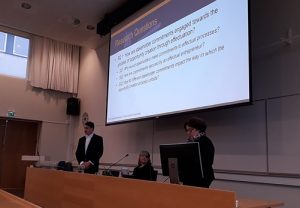In the spring of 2018, I knocked on the door of TSE, department of International Business (IB), with my doctoral research proposal. After approval, I was able to enter the IB community. Embarking on a Ph.D. is unique, and we all take up our own paths towards accomplishments. For me, though, having previously been working on various development cooperation projects, this is where I move from. The work I did involved traveling across continents mostly between the EU and the developing world. But I will narrate a bit more about my experiences and the valuable insights I gained from it. It is from here that I intend to explore further through acquiring scientific knowledge, and IB this the right place to be.
Since 2012, I have been part of international expert teams implementing and doing various development cooperation projects especially in developing countries. As you may know, project is tendered and bid for; thus, it is a game where you either win or lose. My main area of expertise is broadly in Private Sector Development tasks, that is, formulating strategies for economic growth and poverty reduction in developing countries. Perhaps before I continue narrating, it’s better that I describe in brief about the types of projects. Actually, the essence of development cooperation projects is to render support and complement efforts of developing countries to guarantee the provision of universal social basic needs of their citizens along and fundamental human rights. Development cooperation projects that are not profit-driven, but some try to seek a lower profit.
Perhaps, for now, let me share with you a couple of my experiences and field missions which are synonymous to data collection as in research, but this requires onsite presence. Field missions are performed in academic research or other and consultants, as for me. Normally, before the onset of a field mission, experts are selected to implement a project with timeline. So, about a couple of years ago, we won a tender where I was admitted to an international expert team. I was on a Global Environment Facility (GEF) project funded by the African Development Bank (AfDB) and UNDP, which was to be implemented in and around communities of Lake Tanganyika in Zambia. The primary purpose of the project was to provide a baseline scenario of Lake Tanganyika, livelihoods, socio-economic, and environmental situations. So, our tasks were to examine existing strategies and constraints faced by local communities living around the Lake in pursuit of economic activities for sustaining their livelihood and income opportunities
The journey to the field began early morning in order to cover 800km to Kasama town. It was indeed a long trip, tiresome but exciting as we drove through beautiful landscape, as you can see in the photograph below. I selected this photograph from my album because I find it meaningful. In the sense that our lives, careers, and just like research, are journeys with curiosity and where you can encounter the unknowns on the path to your future. But as we all know, at least I think so, staying focused on the road can guarantee a safe arrival to your destination, similarly for our undertakings. So, we arrived at our destination safely and we straight away went to doing our field activities with our first meeting in one community. While in village residents gathered, and we divided theme into groups by age and gender. As such our questionnaires had an open-ended question, for interactive discussion. Before we began the activities, we first had to pay courtesy to the village chief, for permission. Doing so is a standard protocol to get the right to interview people in the community, you may sort of call as data protection. But we needed to explain the purpose of our visit, study, why it’s needed, and the benefits it will bring to the people. Well, we managed to collect data and successfully prepared our findings with recommendations to be implemented. It was an exciting mission and our finding was that there was significant depletion of natural resources such as forests across the region. But the thing which baffled the most within our findings was that of all the communities we interviewed, about 95% of the people, had not heard about Climate Change, as of 2015. One of the main reasons was the poor outreach to rural areas and weaknesses in the institutions. In brief, our recommendation included strategies that focused on supporting conservation of natural resources, adoption of land management and support to SMEs, young men and women entrepreneurs in the fish value chain.

In June 2019, I embarked on a unique field mission to Mogadishu, Somalia , to perform a feasibility study on the Business Incubation ecosystem to be supported by the European Commission (EC) for international development cooperation or Europe-Aid. This was a unique mission because it was my very first time to travel to a country that is on the recovery from decades of civil war. I spent ten days in Mogadishu, and in safe hands. The next day, I was driven to the city of Mogadishu in an armored car with my security guard, to go and conduct my first interviews at an iRise Innovation Hub. Although I was uneasy during the whole mission, I was glad that the whole mission went well. What I find more interesting was that, despite of the global news about Somalia, it was business as usual and life looked normal. In brief, our report proposed capacity building from top to down of all key actors involved in entrepreneurship ecosystem based on the context of the country.
I will conclude with my recent visit to Berlin, where I attended the 18th Academy of Business in Society (ABIS) colloquium, where I presented a conceptual paper. The seminar was hosted by The European School of Management and Technology (ESMT-Berlin), the theme was Business in Society; Measuring and Creating Change. The event was exciting, with good vital speakers and panel discussions. There was a good representation from academia, corporate, and non-governmental organizations. The opening speech and panel discussion included Professor Yury Blagov, St Petersburg school of management, Dr. Ivo Matser, CEO for ABIS, Professor Tamer Boyaci ESMT Berlin, Associate Professor Lin Lerpold, Stockholm School of Economics and Katariina Stenholm, Senior Vice President, Danone Corporation among others. The debates and arguments hovered around the best practices on impact investing and mainly on the trade-off issues of social impact versus market-rate returns. In a nutshell, our homework as researchers is to investigate further how an investor can do good for society while doing well in business.
On this note, I will end here. Such have been my experiences in international business, and with these, that’s the path of my research. As such, most development cooperation programs embed the theory of Change, filling in the gaps of change initiatives.
Ephraim Daka,
Ph.D. Student, International Business


Recent Comments